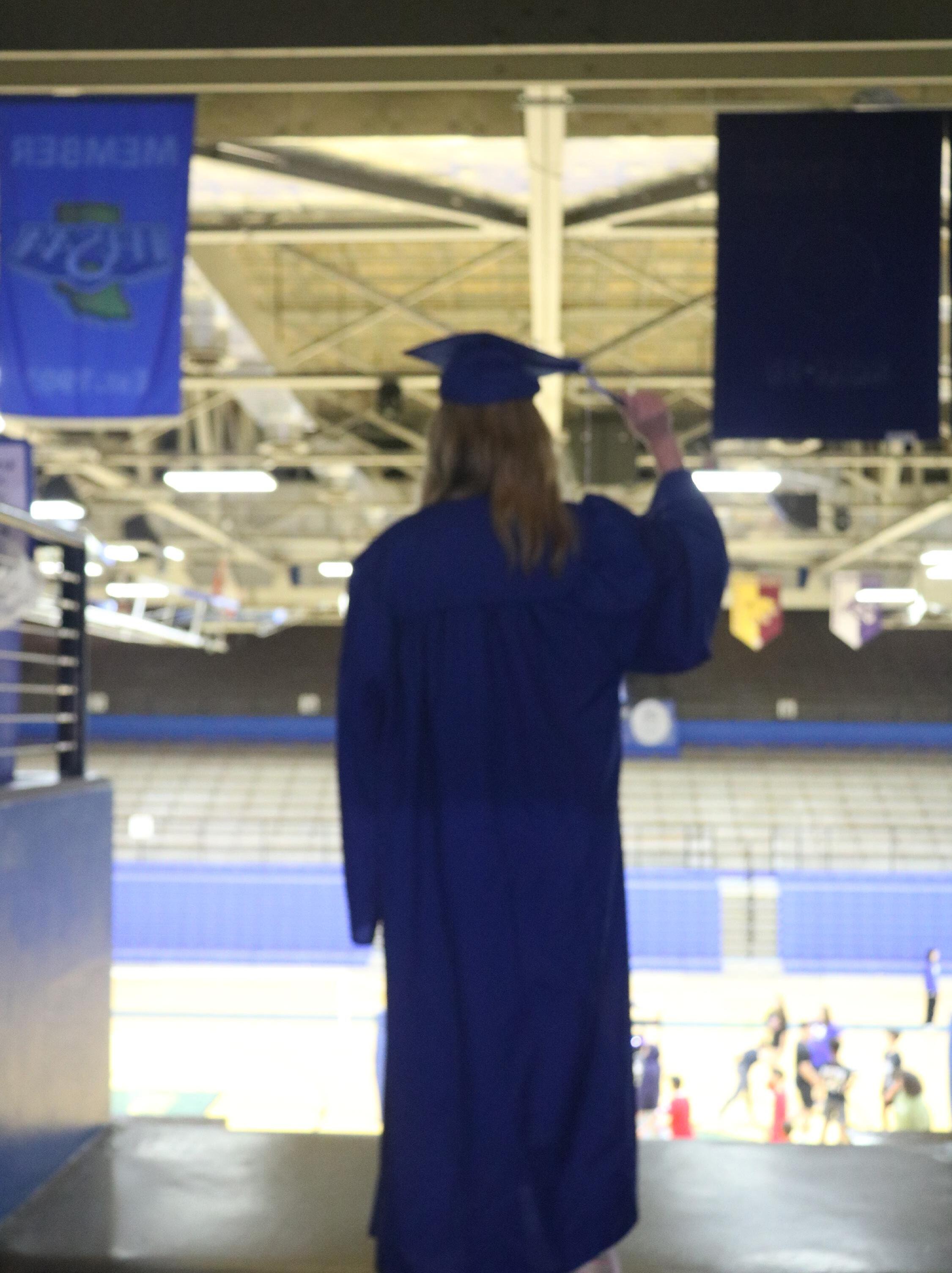
CREATING THE COHORTS Columbus North High School • 1400 25th Street, Columbus, IN 47201 • Volume 103 Issue 1 • September 22, 2023 THE T RIANGLE
EDITORS-IN-CHIEF
Alex Osburn
Ajay Singireddy
Jasmine Yang
IN-DEPTH TEAM
Izzy Munn
Sylvia Sasse
Deshna Venkatachalam
Lydia Weed
PHOTO EDITORS
Novah Ulm
Grace Wheatley
ART DIRECTOR
Sylvia Sasse
SOCIAL MEDIA TEAM
Chloe LaVelle
Brynn Stewart
Deshna Venkatachalam
STAFF
Jocelyn Aguilar
Sarynel Barbosa
Nicolas Bowers
Aidan Brown
Liz Carrigan
Gabe Carrillo
Claire Davis
Annie Green
Jaedyn Greenlee
Lois Guest
Maia Jamieson
Kiko Thompson
Emma Warnock
CREATING THE COHORTS

BCSC high schools create a systematic approach to building relationships with students in order to increase graduation rates
PREVIEW ONLINE

ADVISERS
Roth Lovins
Rachel McCarver
Editorial Policy
The Triangle is the designated forum for student expression at Columbus North High School. The student staff chooses all content.
Signed columns published in The Triangle express the writer’s personal opinion and not the views of The Triangle, student body, BCSC, administration, board of trustees or faculty of Columbus North.
The Triangle practices ethical journalism by providing balanced and fair coverage as determined by community standards. The Triangle strives to achieve 100 percent accuracy by checking sources, spelling, and quotes and attaining multiple sources.
The Triangle encourages letters to the editor, but reserves the right to reject them for reasons including but not limited to lack of space, multiple letters of the same topic and personal attacks contained in the letter. The Triangle will not edit for content, but reserves the right to edit for grammar and length. Letters should be submitted to room 1507 or sent via e-mail to administrator@ cnhsmedia.com. All Letters much be signed by all persons involved in writing the letter, which the staff will check for validation. A letter sent via e-mail must be validated with a signature from the writer before The Triangle will publish it. If responding to a publication, letters must be turned in within one week of that
publication’s distribution.
In the event of death, The Triangle will run a standard obituary. Pertaining to work submitted via social media sites (Facebook, Twitter, etc.), The Triangle will only accept written submissions from the original poster and owner and will only publish entries with the permission of the original poster and owner. The Triangle will not edit submissions for content and reserves the right not to publish them for reasons including but not limited to lack of space, multiple submissions of the same topic, vulgar or incendiary content. The Triangle will not publish photographs from Facebook. Posts on The Triangle’s social media pages by readers are owned by the readers and do not necessarily express the views or opinions of the staff. The Triangle is not responsible for their content and reserves the right to delete and report any inappropriate and unnecessary posts. By posting on The Triangle’s social media pages, the poster grants The Triangle permission to publish the contents of that post. In cases when a source’s information may bring ridicule or incrimination upon himself or herself, the editorial board reserves the right to cite the source as anonymous. The Triangle will never use composite sources and pass them off as anonymous sources.
2
INDEPTH 16 TABLE OF CONTENTS
Scan with your iPhone camera (Snapchat, too) to be linked to all of CNHS Media's socials.




3 NEWS 4 SPORTS 20 NEW SET OF COACHES Girls volleyball players discuss how they’re being impacted by new coaches 21 8 STUDENT LIFE 4 THE ANTIQUE THEATRE Columbus’ historic landmark has reopened SET FOR SUCCESS Administrators and teachers offer insight into new academic and discipline policies this school year 9 5 EXHIBIT COLUMBUS IS BACK Creators of Machi discuss design process for Exhibit Columbus OPINION 12 WHO IS TAYLOR SWIFT ANYWAY? Claire Davis investigates the reasoning behind the hype of the Taylor Swift Eras Tour. 12 A SUPERIOR OPTION Why Canvas is better than ItsLearning 12 ART FOR ALL Senior Kiko Thompson aims to share her love of art with the school community 8 NORTH VS EAST Student athletes discuss how their teams prepare for North vs. East week 20 6 UNITED STATES CITIZENSHIP TEST IS A NEW REQUIREMENT TO GRADUATE How teachers and students feel about this new law 7 LOCAL VS. PRESIDENTIAL City council and mayoral candidates discuss the importance of local elections FRESH CLASSES Students and staff describe new classes being offered this year 10 MAINTAINING MENTAL HEALTH Student and staff discuss strategies for maintaining a good mental health 11 ARE THEY WORTH IT? Analyzing whether the choice of implementing lanyards this year is worth it in the end 13 WE’RE DOWN WITH THE WGA Writers are on strike, hoping the pressure of their absence will force the hands of powerful executives 13 GLOBAL GOALS Junior Juan Jose Salcedo Calderon shares his soccer journey across the world 22 YOUNG TALENT SHINES The varsity football team discusses lineup changes and their goals for the season 23 5 EXHIBIT COLUMBUS IS BACK Creators of Machi discuss design process for Exhibit Columbus ART FOR ALL Senior Kiko Thompson aims to share her love of art with the school community 8 NEW SET OF COACHES Girls volleyball players discuss how they’re being impacted by new coaches 21 FRESH CLASSES Students and staff describe new classes being offered this year 10 TABLE OF CONTENTS
THE ANTIQUE THEATER
The building of the Crump Theatre was built in 1874.
The Crump opened as an opera house on Oct. 30, 1889.
It showed its first movie in 1914, “When Broadway Was A Trail.”
The Crump Theatre closed its doors in 1987.

The Crump Theatre reopened on Aug. 11.
Source CinemaTreasures
“I think it’s pretty cool it opened up since it’s an iconic location in Columbus.” senior Colby Lovins
“For me, I do a lot of music stuff and it might be a cool opportunity to perform on a new stage. I look forward to going and seeing interesting things or potentially performing there with my band.”
Lovins
“I think it’s really cool seeing all the things they have been able to host in the few weeks of them being open.”
Lovins
4
Columbus’ historic landmark has reopened by Annie Green design by Gabriel Carrillo
NEWS
photo by Annie Green
EXHIBIT COLUMBUS IS BACK
MAP OF EXHIBITS
Creators of Machi discuss the design process for Exhibit Columbus
by Liz Carrigan design by Claire Davis
Downtown comes to life as Exhibit Columbus designs are put up. Colorful structures and exhibits represent various creators around downtown. Each exhibit maintains its own story and has a unique creative process behind it. North’s C4 architecture class designed and built one of these structures.
Architecture teacher Darin Johnson explains the process behind North’s architecture program becoming involved with Exhibit Columbus.
“We started in 2016, it’s a two-year cycle,” Johnson said. “So we spend the even number years designing and the odd number years building and installing. So in 2016 we designed Density and then we built it in 2017. That was the biannual year and then Tunnel Vision in 2021, and in 2023 we did Machi.”
Senior Grishma Pitkar shares a bit about the brainstorming process behind their installation this year.
“We started to brainstorm ideas for Public by Design which was kind of the prompt that was given, and we started to come up with ideas and developed the idea of a roller coaster,” Pitkar said. “Eventually we gave it a name which is Machi, which stands for a Japanese downtown.”
Pitkar describes her class’s approach to the installation.
“We wanted to make sure we had gone off the theme Public by Design, so we kind of approached it in a different way,” Pitkar
MAP OF EXHIBITS
said. “We approached it in a way so that the public can use our design to create their own design.”
Johnson speaks on the impact partnering with Exhibit Columbus has.
“I think it’s a great project for C4, the interdisciplinary part of it, where several of us work together,” Johnson said. “Architecture and building trades always work together.”
Pitkar describes the ups and downs of designing.
“The most fun part of designing it was actually putting it together at the site, and
painting the cubes,” Pitkar said. “I feel like the challenging part was making sure everybody was available during the summer since we worked on it during the summer. So I feel like availability was kind of an issue.”

Pitkar additionally shares her favorite parts of designing the exhibit.
“My favorite part is obviously the reward, which is opening night.” Pitkar said. “Rendering is my favorite part, which is actually getting to see your design complete and in real life. It’s just really cool.”
5
3
photo by Novah Ulm Exhibit titled “A Carousel of Columbus” located on 4th Street in Ovation of Columbus
“Designed by the Public” Library Plaza
“Echoes of the Hill” Mill Race Par
“P
2 2 3 1 1 4 4 5 6 6 5
“A Carousel of Columbus” Ovation Of Columbus
ipe Up” Hotel Indigo
“Machi” Cummins Parking Lot, East k NEWS
“Interocolus” 4th St. and Washington St.
MAP OF EXHIBITS
UNITED STATES CITIZENSHIP TEST IS A NEW REQUIREMENT TO GRADUATE
How teachers and students feel about this new law
by Lois Guest design by Emma Warnock
Indiana Code 20-30-5-7(d) was taken into effect in November of 2022. This means that high school students are required to take the United States citizenship test to graduate. This new legislation has been met with mixed reviews. Social studies teacher Dan Marsh views this requirement as more of a checkpoint for teachers rather than for students.
“Honestly, I think it’s one more thing the state government is just extending on the schools that doesn’t necessarily show any big picture,” Marsh said. “I see no true value in taking it other than the fact that we can show the state that yes our students actually are learning the stuff that they think that they may not be.”
Marsh thinks this law is motivated by monitoring teacher accountability and reflects on the relationship between educators and politicians.
“We are unfortunately in a situation in the state of Indiana as well as many other states, that our legislatures are not trusting our teachers,” Marsh said. “They think that we don’t know what we are doing and we are not following what the state standards are, but we’ve got great teachers in this building and we’ve got great teachers in this state.”
However, from the perspective of students that have experienced the citizenship process firsthand, this is an opportunity to show what their parents went through. Senior Mateo GámezLamadrid was born in Columbus, while
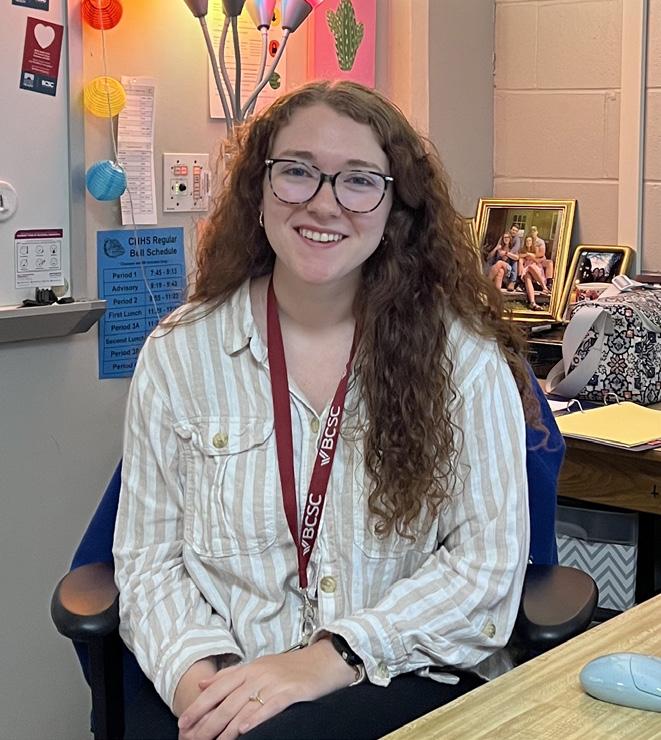
his parents were from a city in Mexico. His parents took the U.S. citizenship test in June of 2016.
“I helped them study for the civics portion of the test,” Gámez-Lamadrid said. “We bought this CD, and whenever we were in the car we would play that CD and listen to it.”
Similarly, senior Evie Hipwood has parents from the United Kingdom that also took the citizenship test.
“We did lots of studying for many months,” Hipwood said. “Lots of flashcards and practice quizzes. We also went through the more complicated systems, like checks and balances, and the separation of powers.”
Hipwood sees both sides of the debate about this law.
“It is important to know about the society you live in, and how you can be an upstanding citizen,” Hipwood said. “However, I don’t think that a test is necessary for people who have lived their whole lives in the country. “
She does believe this test could help some natural-born citizens understand the process of becoming a citizen.
“I think in some areas it will give new light to the struggles of immigration and how difficult and expensive it is,” Hipwood said.
Q&A
with government teacher Emma Watkins
Q: What is the official requirement with this law?
A: [Students] have to take th e test to graduate, but passing is not a requirement.
Q: What is the main thing that this test is teaching students?
A: I think taking the test gives them just a little bit of a glimpse at what upcoming citizens have to know and prepare for in order to become citizens in this country.
Q: Will your students have time to prepare for this test?
A: Yeah we’ll be preparing for it because we know that it’s coming and in terms of the curriculum throughout the semester the questions on the civics test are pretty simple.
Q: How many questions are on the test that the students will take?
A: It will be 10 questions that should be pretty easy.
Q: What do you and the state want from the results of this test?
A: The state wants to know what percentage passes which is getting a 60% or higher and I would say my goal hopefully will be 60% of students get at least a 60%.
Q: Will this test make students understand the process more from the standpoint of someone trying to gain citizenship?
A: If they are not already empathetic. I think what we’ll be studying to prepare for it will make them understand how difficult that process can be.
6
NEWS
photo by Grace Wheatley
LOCAL VS PRESIDENTIAL
City council and mayoral candidates discuss the importance of local elections
by Nicolas Bowers design by Jocelyn Aguilar
Every four years, thousands of Columbus residents go to community centers, schools and churches to vote for their new mayor and city council. According to annualreviews.org, local elections have the potential to make a greater impact on people’s lives than national elections. Despite this greater impact, they later state that local elections are being overshadowed by national elections. Mayoral candidate Mary Ferdon believes that both elections can be viewed as important due to various factors.
“Both elections are important for different reasons,” Ferdon said. “At the national level, the president and Congress set high level policy around national security, housing, education, agriculture, health and transportation. Their job is to debate, compromise and fund. Decisions made by your mayor, city council, school board and county commissioners affect your daily life. Local government makes sure you have your trash picked up, clean water to drink, parks to hang out in, drivable roads, decent schools and police and fire protection. Local government done well should make your life easier.”
City Council candidate Eric Riddle supported many of Ferdon’s ideas and agreed that in the end, all elections are important.
“I don’t place a value judgment on importance,” Riddle said. “All elections matter. Often, people get their start in local elections and may run for higher state and national offices over time, which means that outcomes of local elections have ripple effects that may not be known for 10 to 20 years later. In local elections, you have more direct contact with the candidates before and after they are in office, so those elected officials can more easily respond to your needs.”
City Council candidate Elaine Hilber said that while local elections might have more impact on our daily lives, other elections shouldn’t be disregarded.
“Local elections tend to affect people’s day to day life a lot more than national elections,” Hilber said. “National elections often focus on big items, and while those are important, those changes are rarely made.”
City Council candidate Keegan Hill emphasizes the importance of voting. He believes it is especially important to gain a younger vote.
“The student vote is important for many of the same reasons everyone should vote. It’s your right, it’s your community and your opinion
matters,” Hill said. “It’s also worth noting that our youngest voters are going to have to live under and have their future more impacted by the policies enacted today.”
City Council candidate Tom Dell supports bringing political conversations into schools as a way to ensure students are able to be engaged with local politicians.
“I think that we as elected officials should reach out to students by going into their classrooms at their schools and listen to their concerns,” Dell said. “I believe that would help them understand and get them involved.”
According to the National Library of Medicine, there has been discussion about whether to change the voting age to 16. City Council candidate Alex Engelbert is keen on keeping the age at 18.


“Our state and society have long established 18 as a watershed age when many privileges of adulthood are bestowed,” Engelbert said. “Not just voting but the ability to make decisions about legal matters and healthcare as well. I am comfortable with keeping the current age because all those freedoms are so important and require mature judgment.”
City Clerk candidate Quisha Jackson has a different opinion.
“Yes, I think the voting age should be lowered,” Jackson said. “I find it ridiculous to think a 16-year-old can drive a motor vehicle but is not trusted to vote on issues that impact their lives. I strongly feel young people are competent enough to understand the topics that directly influence them and make intelligent choices at the ballot box based on that understanding.”
City Council candidate Josh Burnett believes that the city’s policies are intended to benefit everyone and highlighted how they help high school students.
“If elected, most if not all of the items I would vote on as a city-councilman-at-large would impact the quality of life for everyone who calls Columbus home or chooses to work and visit here,” Burnett said. “I would like for our city to keep improving in any area that will encourage teenagers and young adults to either stay here after high school and college, or help them feel proud when telling their friends in a big city that they are from Columbus, Indiana.”
All candidates with public email addresses were contacted
7
“
For a high schooler. it’s really important to begin thinking about their political identity and with their local leaders. ” senior Ryan Hottell
“
NEWS
I think it’s important to vote in local elections because you can make the change within your community that you want to see happen.” senior Faline Fox
photos by Grace Wheatley
ART FOR ALL
by Ajay Singireddy design by Maia Jamieson
Senior Kiko Thompson aims to share her love of art with the school community

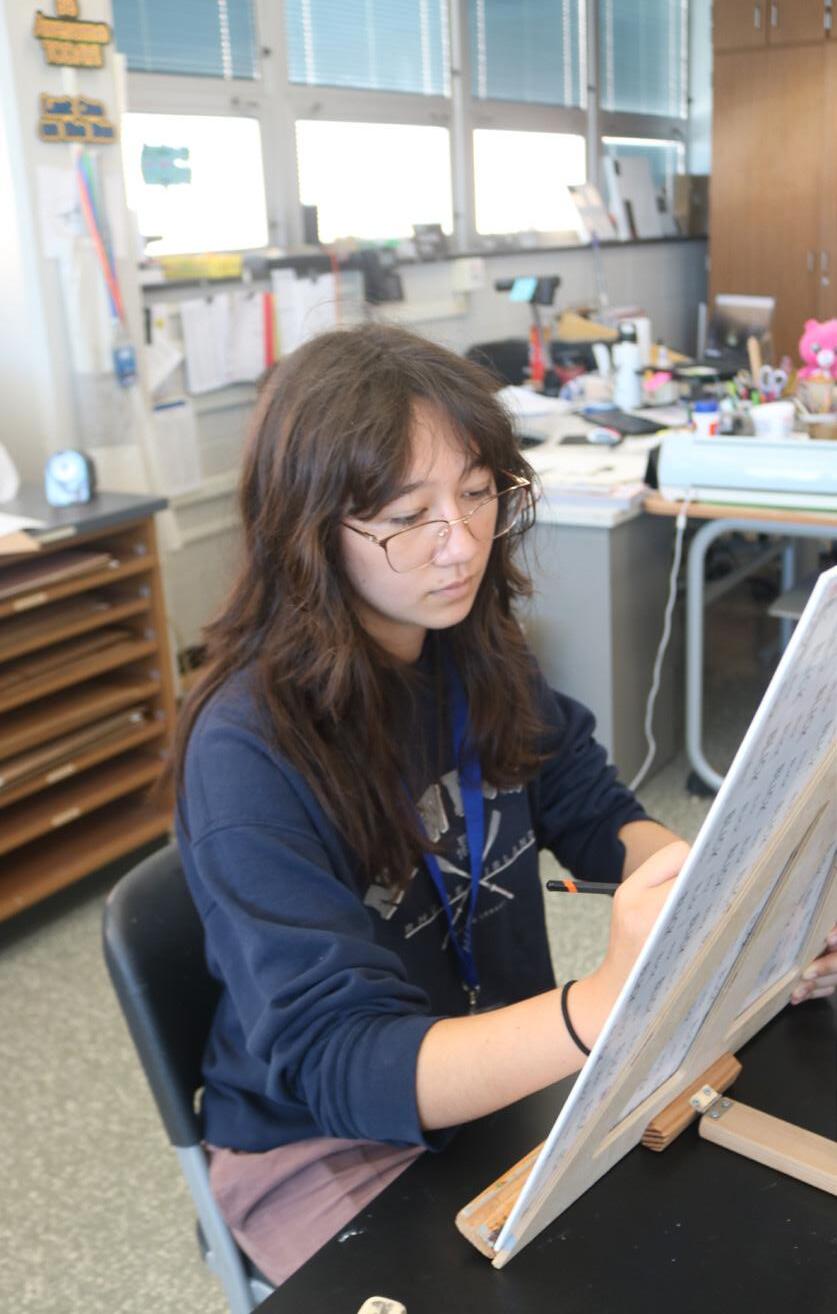
For the average person, creating comics may seem like a superpower more befitting of the heroes in the pages, but senior Kiko Thompson disagrees. Thompson aims to make the art of comics more accessible to students here through her senior project.
“I’m holding an event where I teach people how to storyboard comics or small comics,” Thompson said.
Thompson has always found storyboarding especially rewarding and wishes to share this joy with other students.
“I really wanted people to storyboard things, because storyboarding has always been my favorite part of making comics,” Thompson said. “It’s just putting ideas on paper and I think that’s super fun.”
This particular aspect of making comics is something that anyone can do regardless of their skill level or experience, as Thompson explains.
“You don’t need to have any artistic talents to storyboard a comic really,” Thompson said. “You just need
to have an idea and draw stick figures and be able to write little speech bubbles.”
Thompson further explains that art is broader than people initially realize.
“Anyone can do art-type things, and art is so many things,” Thompson said. “I think comics are one of the greatest examples of writing and storytelling mixed with art, and it’s wonderful.”
Art and comics are a worthwhile form of expression for Thompson.
“It’s just fun,” Thompson said. “It’s so liberating having your own world and story to be able to develop and do whatever you want with it. It’s so fun to talk about, especially with other creators, and things like that.”
Though Thompson started making comics in middle school, she has been drawing for much longer.
“I’ve been drawing since before I can even remember honestly,” Thompson said. “I pretty much was born with a crayon in my hand.”

However, Thompson still firmly believes that art can hold a place in anyone’s life, regardless of their artistic ability.
“There’s so many parts of art and beauty that can be interlinked and I want people to understand that you don’t need to be an artist to tell a story,” Thompson said. “Anybody can do it.”
8
art by Kiko Thompson
STUDENT LIFE
photo by Grace Wheatley
SET FOR SUCCESS
Administrators and teachers offer insight into new academic and discipline policies
by Alex Osburn design by Aidan Brown
The beginning of class: a teacher calls a student’s name and silence is the only response. The digital environment during the school day: hurtful and threatening messages appear on a student’s phone. The counselor’s office on the third day of school: a line of students anxiously waits to drop classes.

Students, teachers and administrators must balance not only the academic components of high school education, but also the social, environmental and safety factors. This school year, new and updated policies surrounding both afterschool academic programs and course withdrawal are being introduced to benefit the school community. Cohort ‘26 assistant principal Jennifer Hester describes how the re-introduction of Friday detentions and Friday school is meant to encourage positive behavior and avoid possible future repercussions.
“Any time you have a detention, a lot of times there’s this big negative connotation with it,” Hester said. “But I see it as us trying to teach kids how to behave without a huge consequence before maybe they do something or make a decision to do something that is a huge consequence for them or someone else at school.”
From English teacher Barbara Handt’s perspective, the establishment of this detention policy may prevent such behaviors before the students are assigned to stay after
school on Friday.
“The Friday school policy, I think, can be a deterrent to people that are repeat offenders for different things because no one wants to have to stay late on Friday,” Handt said. “I hope that is a deterrent to students, that they [only] get reminded or written up a couple times for something.”
Along with these two after-school
“If someone may be struggling with academics, missing assignments, participation, various things of that nature, they may be in [academic Friday school] as well,” Simpson said. “It’s coming back to an emphasis on giving extra supports to help students with their academic work.”
Similarly, the withdraw/fail policy hopes to support the school community by limiting the amount of schedule changes after the school year begins.
“The intent of it is to protect students making the schedule based on their interests and what classes they want to take,” Hester said. “A lot of students were going to a class for two or three days or a week and then they just wanted to drop the class. So then we had to put them in resource, then the resource numbers got too big, and then that class got too small, but we can’t let other kids in because we no longer have capacity to see which kids had signed up for it.”
programs, an option available to all students this year is academic Friday school. It takes place from 3:30 to 5:15 on Fridays in the library conference room, and it allows students to work on schoolwork with the support of a staff member. Cohort ‘24 assistant principal Levi Simpson elaborates on the benefits this will provide to students.
EMPTY SEATS
Along with supporting a more stable roster during the first few weeks of school, science teacher Anshu Agrawal explains how additional encouragement to completely finish courses can benefit students past high school.
“If a student drops, certainly they will not learn anything because they will not have the social skills, they will not have the good academic skills,” Agrawal said. “So professionally, if you need to do a job or anything, it’s really necessary. Those basic skills are really necessary.”
9
BCSC Attendance Percentages from 2010 to 2019 100 80 2010-11 2011-12 2012-13 2013-14 2014-15 2015-16 2016-17 2017-18 2018-19 2019-20 North East BCSC Average % Attendance School Year Source IDOE
STUDENT LIFE
photo illustration by Grace Wheatley Detentions and Friday schools will be held in room 1004B
FRESH CLASSES
Students and staff describe new classes being offered this year
by Jasmine Yang design by Jaedyn Greenlee
Flipping through the endless pages of the course catalog, students can struggle and stress about filling out their course selection sheets. Classes that they want to take are not on the list, or there are not any options that are standing out to them. While the same combination of class options year after year can worsen scheduling stress, two new courses are being offered here this year to allow students a chance to pursue a course that is better catered to their wants. Junior Harrison Allen is taking American Studies, a new course offered to juniors, and describes what he likes about it being offered.
“I like that it’s a mix of English and social studies [because] it’s the English part of books and then it’s [also] social studies,” Allen said. “It’s kind of a mix [of them] and it’s something new. I’ve never done it before so I thought I might as well [try] it.”
Freshman Michaela Aker is taking AP World History Modern, another new course this year, and is able to enjoy every aspect of it.
“It’s just a really good class,” Aker said. “It’s the only class that I have that we have a lot of discussions in and we all learn together, and the teacher is really helpful.”
AP World History Modern teacher Elyse Babb Snider reflects on the benefits of taking this class, especially for freshmen and sophomores.
“I really think it’s a good first course to take because it’s pretty rigorous, so you have to work on non-academic skills like time management and self-discipline,” Babb Snider said.
American Studies teacher Kelley Culp describes how teachers are also able to benefit from having these new courses offered, as they bring new opportunities, freedom and ways of teaching.

“Mr. Marsh and I are able to co-teach, so we are in the room together and we are able to kind of feed off of one another and talk about history and literature and how it works together,” Culp said. “It’s just a whole new dynamic than when you’re just in the room by yourself.”
WHAT DO THEY OFFER?
American Studies
Combination of American
Literature and U.S. History
Every day
Analyze American Literature with a historic approach
AP World History
Look at year 1450-present day
Focus on all areas of the world
Start looking at primary sources
Analyzing documents
10
photo by Grace Wheatley
Teacher Kelley Culp introduces “The Crucible” to the American Studies class.
STUDENT LIFE
MAINTAINING MENTAL HEALTH
A student and a staff member discuss the importance of mental health
by Annie Green design by Nicolas Bowers
Since 2008, the NCTSN (National Child Traumatic Stress Network) has established September as Suicide Awareness month.
According to uclahealth.org, suicide is the second leading cause of death in people aged 15 to 24. Approximately 20 percent of high schoolers report having serious thoughts of suicide, and 9 percent of high schoolers report attempting to take their own lives. Mental health awareness has made an appearance in past years, and its importance has started to show in young adults around the world.
A sophomore who has struggled with mental health issues, shared her own thoughts.
“I know mental health is so important,” the sophomore said. “I honestly believe that mental health deserves more attention. I’m so happy that it’s gotten more attention in the previous few years, but I don’t think it’s getting the type of attention it deserves.”
The sophomore shares her own thoughts on mental health and why it deserves more attention.
“I think mental health is more important than physical health, honestly,” she said. “Mental health is often harder to spot than physical health. If you see a person, you immediately notice if they have a broken arm
or broken leg, you can’t always tell how they are mentally.”
“If you’re depressed, anxious, stressed or if you haven’t been eating, you aren’t going to be able to work your best,” Doe said. “So, yes. The well being of your mental health heavily impacts your school work. It makes you more drained and you have less motivation to do things,”
Priorygroup.com states, “Depression can also cause people to isolate themselves, worry excessively about getting work done and feel guilty about letting other people down. They can also find it difficult to talk about how they feel at work, because they feel ashamed that they may be judged.”
If someone is feeling suicidal, depressed, anxious or stressed, there are multiple ways to deal with emotions in a responsible way.
“There are multiple things you can do when you feel hopeless or depressed, even though there isn’t one clear answer,” the sophomore said. “I recommend you talk with a responsible friend, person, sibling, counselor, teacher or therapist. Though it can be hard to remember, there are people who want to help you.”
The sophomore shared what helps her whenever she gets down or upset.
“What usually helps me whenever I get really upset and I don’t think I can handle
my emotions in a responsible way, I often call one of my best friends,” she said. “I often find my spirits lifting when I laugh with people I love and trust.”
Cohort ‘26 counselor Aaron Karrer speaks his thoughts on mental health.
“Mental health is extremely important,” Karrer said. “It affects your daily routine. It affects your school routine. It affects your relationship with friends and it affects your relationship with your parents.”
Karrer spoke on how keeping a schedule can help improve a person’s mental health.
“The biggest thing that I would say and I think it’s very important for kids to understand is that especially when we start school back up, we have a lot of stressors that they didn’t have during the summer, a lot of stressors that they didn’t have in their routine on a daily basis,” Karrer said. “It helps to make sure that the routine is in place so that the school day can be successful. That’s even with eating properly, drinking properly, hydration, any of those things can affect your mental health as well as your physical health, and then it affects your school work.”
11
MENTAL HEALTH TIPS Steps to take care of mental health
Remove yourself from things that could potentially harm you 1. Take a deep breath
Distract yourself (read, listen to music, play video games, etc
Call or text the Suicide Hotline at 9-8-8
Visit the crisis hotline website Source NCTSN STUDENT LIFE
2.
3.
4.
5.
WE’RE DOWN WITH THE WGA
Writers are on strike, hoping the pressure of their absence will force the hands of powerful executives
by Emma Warnock
April 18, 97.85 percent of members of the Writer Guild of America (WGA) voted to go on strike in the case that their demands would not be met by executives. As predicted, the major studios decided to not accept the terms that the WGA demanded. Because of this, on May 2, they began their strike. The WGA strike was a long time coming. Due to the smaller writing rooms and the drying up of residual checks, the big business of screenwriting has become a side hustle that few can afford to do without a second source of income.
Writing rooms have changed in the past few years, with them getting smaller and more disconnected with the project. Mini Rooms are a relatively new concept in Hollywood, but it is causing writers with less experience to do more work for less pay. Additionally, the size of regular

writers' rooms has shrunk compared to its counterparts in the golden age of television. The major studios’ effort to cut costs has led to inefficiency in writers rooms causing writers to not perform as well as they could. Streaming was not as popular as it was during the last WGA strike in 2008. Streaming executives have used this to their advantage by cheating writers out of the money that they deserve for their work. Because streaming services are not required to release their viewing records, they are able to pay virtually nothing in residuals as no one can confirm the amount of people who are actually watching these shows and movies. This is something that the WGA is trying to fix by demanding that streaming companies are transparent with their viewership. The amount of episodes and the space between seasons on streaming services is also an issue, with writers being
A SUPERIOR OPTION
Why Canvas is better than ItsLearning
by Aidan Brown
With the new school year, BCSC has abandoned ItsLearning, something we’ve had for as long as I can remember, to embrace Canvas.
In the few weeks I’ve had with Canvas, I think the switch was well worth it. ItsLearning as a system was fundamentally flawed and did not work for our school. It was unintuitive, difficult to navigate, and the interface was so unnecessarily crowded it was difficult to find what was important. In addition to this, It was extremely glitchy on the school computers. It took ages to load, and when it did, half my screen would be blank. Canvas runs much smoother on the school Chromebooks and the interface is so
much easier to use and navigate. Gone are the needlessly complex trees of files and the crowded home screen.
Assignments are all in one place, you don’t have to go through a maze of links to get to assignments and most importantly, the assignment submission works. It was not uncommon to submit things on ItsLearning only for the connection to break and have to redo it, or it would be saved as a draft instead or for the document permissions to be incorrect. These problems seem absent in Canvas.
Canvas has improved upon ItsLearning’s assignment system further by having better groups, PDF scans in the app, automatically setting document permissions, not having to copy documents to use them, automatically
paid for four to 13 episodes, instead of the traditional 22 to 26 episodes. Instead of waiting a couple of months to go back to work on a show, some writers now have to wait a year or more to begin work for that same show again. This takes away steady incomes from writers, making it harder to continue making their art comfortably.
saving your work and having a stable connection. The switch to Canvas for the new school year has been much worth it, and I look forward to having a system that actually works.

12
OPINION
WHO IS TAYLOR SWIFT ANYWAY?
Investigating the reasoning behind the hype of the Taylor Swift Eras Tour
by Claire Davis
With a fan base of 99 million followers and over 200 hit songs, Taylor Swift has been one of the most highly-acclaimed artists this summer. Her most recent debut, the Eras tour, has captivated audiences around the world. The tour has been in over 20 cities across the US and dedicated CNHS students have either attended the tour themselves, like me, or are still fighting tooth and nail for tickets that’ll never come. So why is this tour so sought after, and most importantly, is it worth the hype?
As someone who attended the tour in Cincinnati on night two this summer, and hadn’t intentionally listened to her music prior to the tour, I am the perfect candidate to determine this.
I paid a total of $135 for nosebleed tickets, so I was basically watching the concert
through the huge stadium screens since Taylor was the size of my thumb. Her outfits and the ever-changing stage kept the show entertaining throughout the night. My personal favorite was her set and costume for her popular song “Shake It Off.” Swift was an excellent singer, and her voice stayed consistent the entire show. Her music was also satisfactory, as it kept me dancing and singing the whole night. One of the highlights for me was trading bracelets and interacting with the people around me in the stands. Everyone was so excited to be there, which made the environment of the arena very energetic.
However, for introverts or those who don’t like large, obnoxious crowds, this energetic atmosphere might not be the right place. Another downside to the tour was that the stadium was extremely loud and hot. Of course, this won’t be true for all of her
ARE THEY WORTH IT?
Analyzing whether the choice of implementing lanyards this year is worth it in the end
by Sarynel Barbosa
This school year the students started to use lanyards for safety reasons, to make staff aware of who is supposed to be at the school. Some pros about lanyards are that they help to know who is supposed to be in the school and who is not supposed to be in the school. Also, they can identify many people from different schools and grades.
However there are other ways to do this like uniforms or badge reels. Some schools use uniforms to identify students, or some use a badge reel. But, there are drawbacks to these too. If the school decides to wear uniforms, some people will be uncomfortable and the students will not have freedom to wear what they want. Badge reels can be comfortable, though, because they can be put on backpacks to identify students easily. The color choices of the lanyards can also affect people’s preference,
and some colors can make people have low self-esteem or not feel comfortable with the color of their lanyard. It might be a color they don’t like to wear or a color they don’t like. Sometimes there is a rivalry between each grade, and differently colored lanyards can cause problems because some people think that they are better than others and they might harass people just because of their grade. Also, school is supposed to let students get along with others by personality and not by grade.
Most students don’t mind using lanyards, but some students forget about them, or don’t wear them how they’re supposed to and they disrespect the people that are trying to help them. Lanyards can also be uncomfortable around the neck, or other students can pull them off and hurt the person. They help a lot for safety to know who is supposed to be at the school, but it doesn’t help with students pulling on others’
concerts, as some are indoors or take place during cooler months, but it still took away from my experience. The last downside to the Eras tour: the cost. Face value tickets went up to $500, but according to stylecaster. com the average resale value goes to $1,619 per ticket.
So the verdict would be that the Taylor Swift Eras tour is in fact worth the hype. Plainly, she delivers an amazing performance that entertains and has captivated millions of people resulting in one of the most fun experiences I’ve ever had.
lanyards and hurting other people’s necks. Overall, lanyards are a safe form, even if they make people uncomfortable or angry. In my opinion they are not bad, they are just uncomfortable to wear. The colors are not my favorite, but I understand that seniors get to wear the school’s colors.

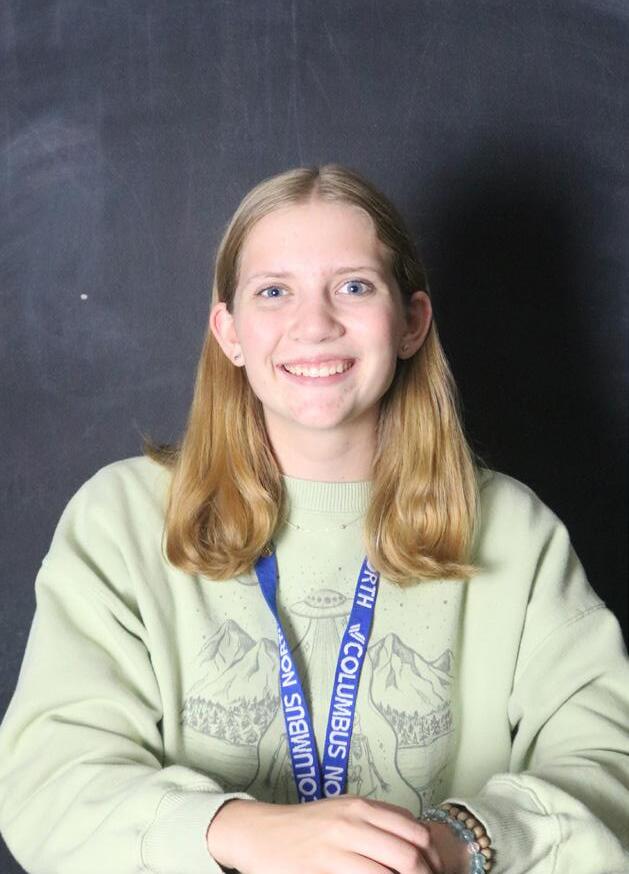
13
OPINION
QUESTIONING THE COHORTS
The Triangle staff examines the potential benefits and drawbacks of the cohort system
“Hey did you hear about school shutting down?”
In March of 2020, school became a choice of whether or not to open a computer. For the last few months of the school year, teachers and students alike did their best to keep up with schoolwork. However, some fell behind and when the next school year began, the loss of motivation followed. Despite being physically in school, some students felt no desire to get any work done. As a result, grades suffered in a constant cycle that some students were not going to overcome. When it came to the end of their senior year, rather than wearing a cap and gown, they were stuck at home in bed.
The overall BCSC graduation rate decreased from 84.86 percent in 2021 to 81.08 percent in 2022, according to state officials. Students failing to complete high school is not a new issue, and recent dips in graduation rates have brought more reasons why high schoolers may drop out to light. According to the National Dropout Prevention Center, factors such as excessive absenteeism, pregnancy, time conflicts between work and school, responsibility to care for family and failing grades are all other recurring reasons why students might not

complete a secondary education.
The cohort system was implemented this school year with one of the goals being to prevent students from leaving high school. Fifty percent of the Triangle staff believes that the cohort system will be effective in raising graduation rates. The shift to unified, grade-specific administrative teams presents the opportunity for high schoolers to have a more personalized experience. Administrators are able to focus their guidance on one specific grade as opposed to the whole school. However, there is also the potential that staff within a cohort team become overworked or involved with one specific situation, leaving too little time to fix too many issues.
Cohorts are more commonly seen in education on a smaller, classroom level. According to Edith B. Jackson Child Care, “the cohort model keeps children and teachers together in consistent groups throughout the academic year.” Having the same combination of students for each class on a schedule can encourage stronger relationships among peers, more collaborative work and higher rates of course completion. A 2017 study at a community college found that for the same program, students who learned in a cohort model were
3.6 times more likely to earn a certificate than students who learned in a traditional model.
However, on an administrative level, the cohort model looks a little different. Having a group of four to five people to coach an entire grade of 450 to 650 students is a much larger task, and it presents unique challenges not present in a classroom cohort. There is the possibility that administrators will be busy talking to one student while another student or teacher needs them. This can lead to situations escalating without the intervention of school officials. Furthermore, some of the causes cited by the National Dropout Prevention Center for decreased graduation rates are out of cohorts’ reach. While they can provide students with resources in the school environment, they don’t have nearly as much, if any, influence over work or family responsibilities or dynamics.
The positive impacts of a tight-knit and collaborative educational environment are seen on a classroom level, but the question remains if similar results will occur on a larger scale with cohort-based administration. Going forward, the impacts of the cohort system will become evident beginning at the end of this school year. Only time and experience will tell just how effective this change will be.
BREAKING DOWN THE NUMBERS
Statewide graduation rates from 2015 to 2022
Source: IDOE
14
2015 2016 2017 2018 2019 2020 2021 2022 80 85 90 95 100 Year Graduation Rate (%)
EDITORIAL
Log yearbook will capture the people, the events and the soul of Bull Dog Nation this school year. At the end of the year be part of the excitement and energy of delivery day by reserving your copy of the 2024 Log now. Don’t miss out on the real story of the year.
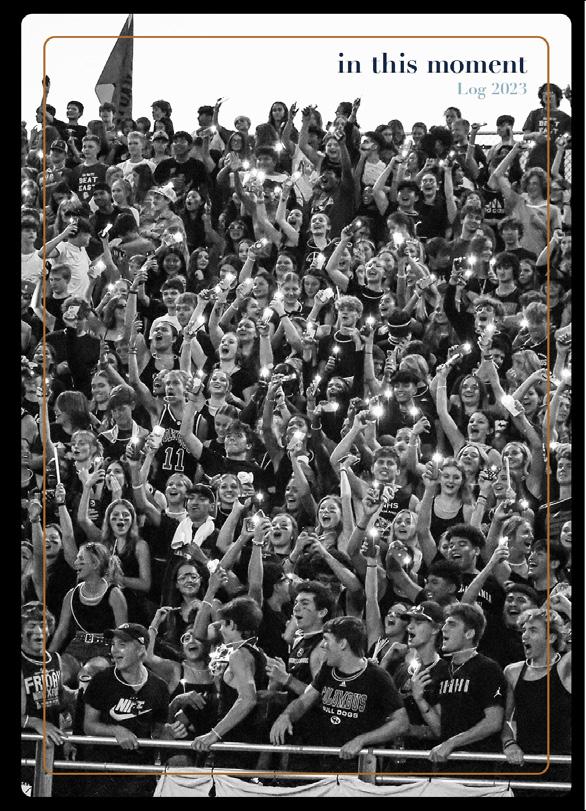

Order your Log yearbook outside room 1505 or order online at bit.ly/logyrbk for its best price of $55 BEFORE OCT. 6. After that, books may be ordered through Herff Jones for $70 until March 8.
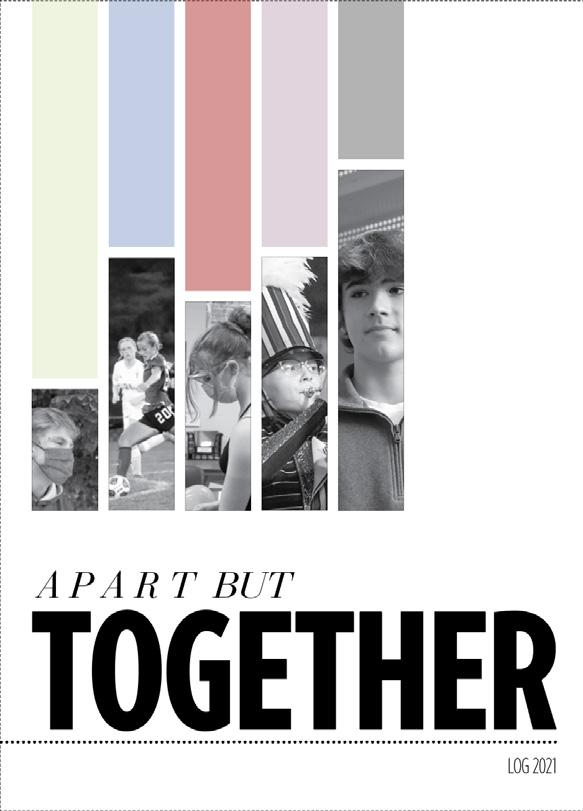
it’s all about 2024
this year
your year
THE year
15
•
•
?
CREATING THE COHORTS
BCSC high schools create a systematic approach to building relationships with students in order to increase graduation rates
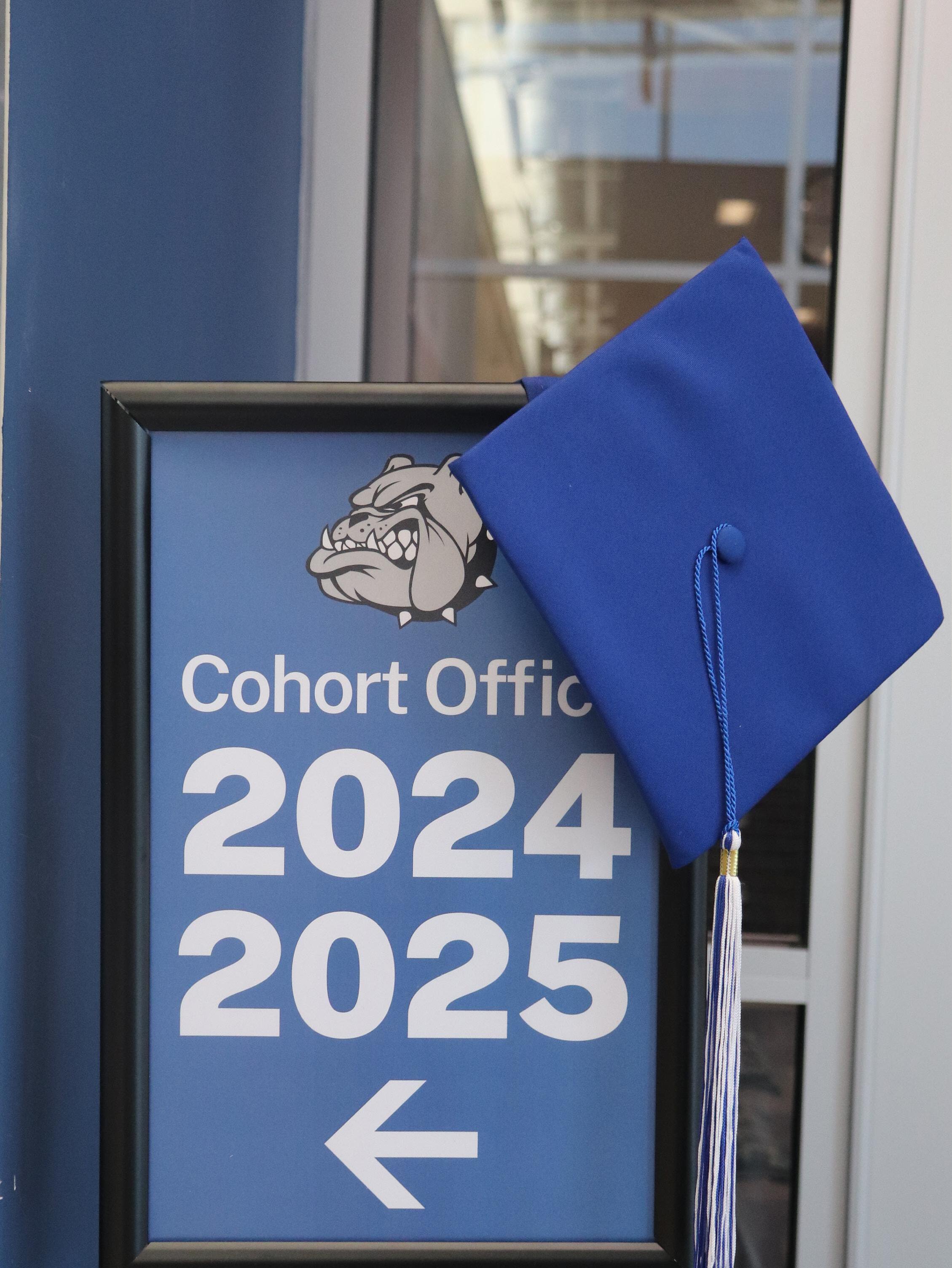 by Izzy Munn, Sylvia Sasse, Deshna Venkatachalam and Lydia Weed
by Izzy Munn, Sylvia Sasse, Deshna Venkatachalam and Lydia Weed
16
IN-DEPTH
Asea of blue fills the gym floor. The day all seniors have been working for has finally arrived. They await their moment to walk the stage in caps and gowns. For BCSC administrators, this is something that they want every student to experience.
According to the Indiana Department of Education, the statewide high school graduation rate was 86.61 percent, as of 2022. Bartholomew County falls below this average with a graduation rate of 81.08 percent. The previous year was 84.86 percent. Zoning in here, the graduation rate falls to 83.22 percent. To combat this decrease in graduating rates, BCSC has implemented a new system. This system creates a stable cushion for students to fall back on, and be more interconnected with adults inside the building. By carrying out this plan, teachers and administrators are more accessible. Superintendent Jim Roberts briefly discusses the planning that went into this project,
“Various ideas were being considered to increase graduation rates for our school corporation,” Roberts said. “During a review of ideas, we were provided information about the efforts of Brownsburg High School by Dr. Jim Snapp, Brownsburg Superintendent. The information received led us to take a stakeholder visit to Brownsburg High School to meet with their students and staff members. This visit was instrumental in deciding to model much of our work after them.”
The ideas to base this model off Brownsburg stemmed from their 99.2 graduation percentage, as well as their school size. However, there were still modifications done to fit both North and East.
“Since we have two comprehensive high schools that would implement any changes, we had to review any differences between them, including student enrollment numbers and staffing, to make system decisions,” Roberts said.

This model was continuously revised until it became what is now known as the cohort system. Cohort ‘24 Academic Coach Amy Rosenberg discusses the basic model of this new system.
“The cohort model is supposed to provide more of a support system for students,” Rosenberg said. “Essentially, it’s most effective when you’re starting at
17
“Supporting our students now helps them reach graduation and will help them throughout their lives, which in turn helps the community,”
Corie Williams
“I think that, in comparison to the old administration system, it works better because now each counselor has a designated grade level rather than being assigned to last names and trying to fit everyone in. Now counselors can help any student in their grade level rather than trying to prioritize a schedule or an issue.”
IN-DEPTH
junior Megan England
COHORT ‘27
COHORT ‘26
MEET THE COHORTS
COHORT ‘25
grade nine. The freshman class will travel with their cohort for all four years so by the time you’re a senior those should be your goto people for everything that you need.”
With this model, each student will be able to effectively communicate with an administrator, among many other opportunities for students. Cohort ‘27 Assistant Principal Corie Williams discusses her goals for the future of this cohort system.
“The ultimate goal of doing this is firstly to increase graduation rates. I hope that our graduation rates will increase because having a high school diploma sets students up for whatever they want to do post-
COHORT ‘24
graduation,” Williams said. “Supporting our students now helps them reach graduation and will help them throughout their lives, which in turn helps the community. The more people we have in our community that have high school diplomas or have pursued things past high school, the better off our whole town will be.”
With the population of BCSC growing, staff are at risk to lose opportunities to form meaningful bonds with their students. As stated by the National Center for Education, the average student to teacher ratio in Indiana is 16-to-1. This cohort system, in addition to boosting graduation rates, will
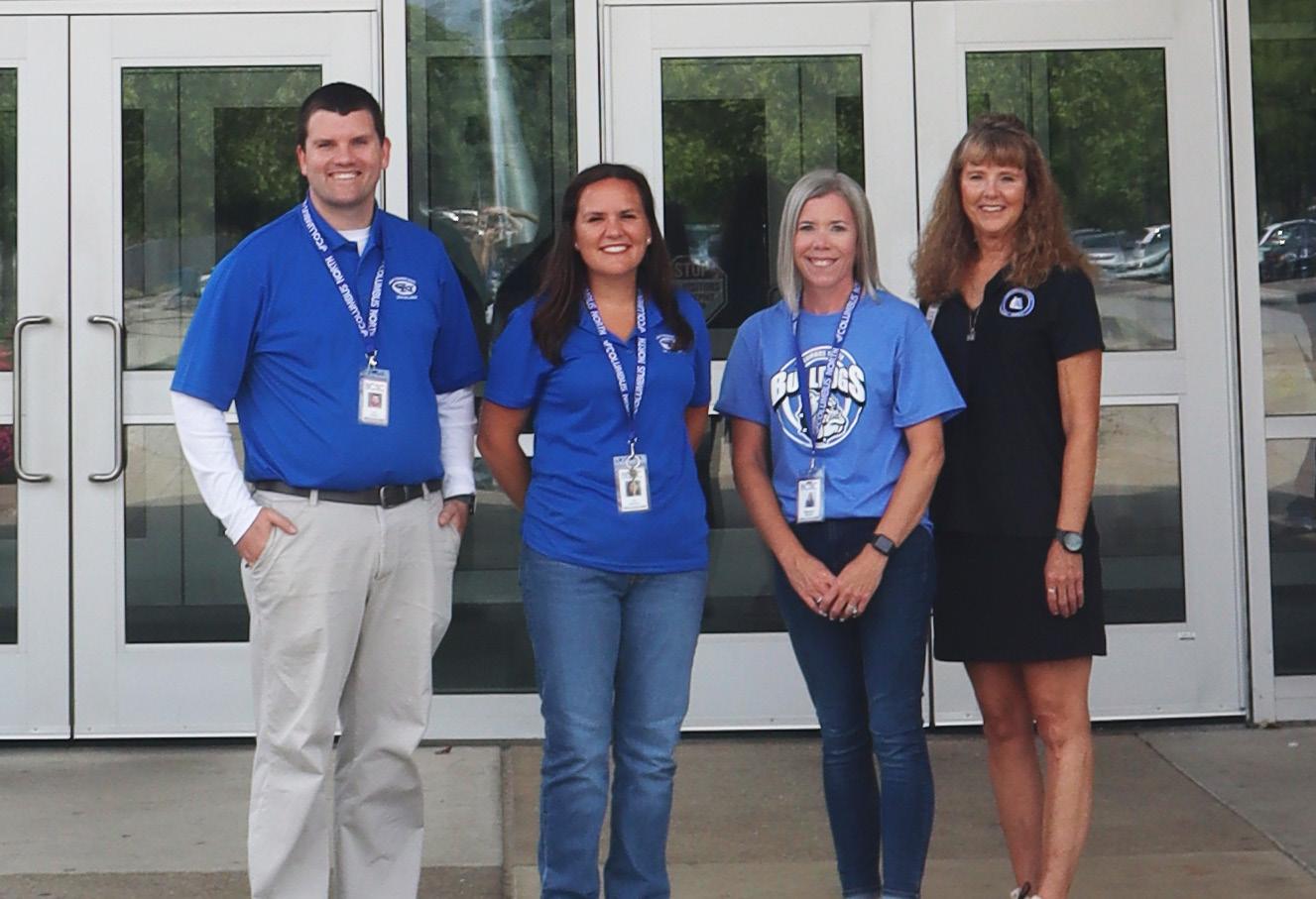

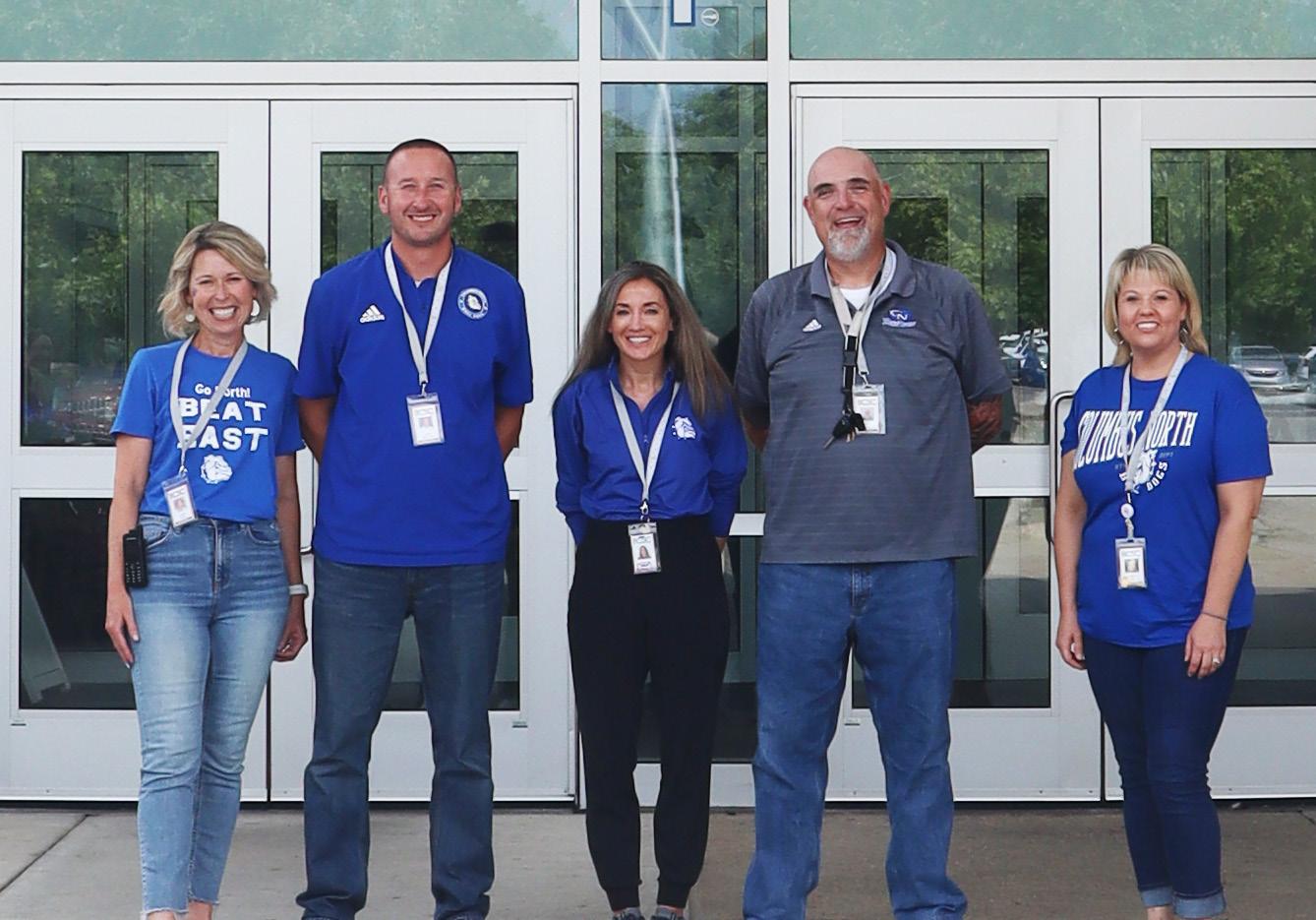

also allow students and staff to form stronger connections. Cohort ‘25 Academic Coach Paul Ferguson highlights how these stronger relationships are a part of the Bull Dog Way. While the three R’s (respect, responsibility and relationships) majorly applies to students, it can apply to staff too.
“One of our three R’s is relationships, and we want to build more relationships with students,” Ferguson said. “I think we have increased our resources so there’s more people in the cohorts to help [students] be successful academically.”
Giving students access to trusted adults and staff throughout their education can help
18
from the left: Corie Williams, Karen Elliot, Jeff Friedgood, Victoria Shireman, Jill Collins
from the left: Levi Simpson, Amy Rosenberg, Becky Brown, Sandy Freshour
from the left: Jenn Hester, Josh Blankenship Tammie Miller, Aaron Karrer, Deena Bates
from the left: Alyssa Mantooth, MJ Shireman, Paul Ferguson, Brelyn Nolting, Kassy Stemnock
IN-DEPTH
other courses at North. Rosenberg states the challenges of trying to talk to students individually.
“It can be kind of challenging for a teacher to interact with a student one-on-one when they are in the classroom setting because of the amount of kids in the classroom,” Rosenberg said.
Additionally, there have been some challenges faced by students and staff, including new security precautions and technological transitions that weren’t in place prior to the creation of the cohort system. Students were presented with lanyards as a safety precaution and had to learn how to use Canvas instead of ItsLearning. Staff members have also transitioned into new roles throughout the school due to the new cohort
system. Ferguson discusses these transitions and what it was like to change roles.
“There were some district-wide services for those of us changing our roles and moving into those new positions, so we felt well-supported at BCSC,” Ferguson said. “At the same time we knew there were going to be a lot of changes, and this is one of those years where we’re going to have to figure out some things and be able to prepare for all the changes. We’re figuring it out as we go along and everyone is committed to doing it and working hard.”
Though the new school year has come with a lot of changes, Rosenberg hopes that creates new possibilities.
“I hope that every kid here has a go-to person, someone that they can confide in
when they feel like they are struggling, worried about their grades, or just for more information,” Rosenberg said. “It’s important to me for every student to feel like they have someone to talk to in the building.”
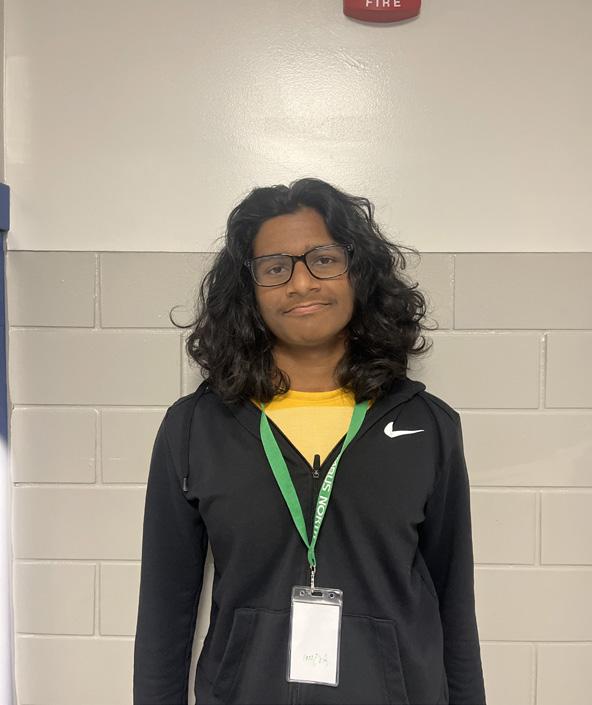
Assistant Principal: Oversees the cohort and deals with major discipline incidents
Academic Coach: Deals with minor disciplinary infractions, attendance, and helps ensure that students are on the path to graduate
WHO DOES WHAT
A brief description of responsibilities each role in the cohort system has
Counselor: Deals with scheduling and make sure they have the right credits to gain a diploma
Administrative Assistant: Deals with mostly attendance and enrollment

19
“I feel the new cohort system was very much needed for some people and irrelevant for others. I think it’s more strict and personal compared to the old system, as it should be.” sophomore Isabella Ruiz
“It’s annoying to have to go to the cohort office every time I forget my lanyard. ”
junior Arjun Pattel
IN-DEPTH
TICKETTOTALS
TotalticketssoldduringNorth-Eastgames
BOYS SOCCER 845 732 GIRLS SOCCER
RECAP OF NORTH VS. EAST WEEK
Student athletes discuss how their teams prepare for North vs. East Week
by Liz Carrigan design by Ajay Singireddy
The stands are filled with people. The football team gathers, in full gear, in a huddle to discuss their play. The next day the ball is placed in the center of the field, as the soccer team takes their positions. In each game the stakes are high. North vs. East week is filled with competitions that each team prepares for differently. The way each team prepares affects their success in the North vs. East game.
Junior girls’ soccer player Erica Kaufman explains how she prepares for the North vs. East soccer game.
“I just try to always be mentally prepared for the big games, but obviously the North vs. East game is a bigger game,” Kaufman said. “I make sure to get a bunch of sleep and stay hydrated.”
Going into the game prepared allows players to feel ready to play to win in their match. Junior boys soccer player Konnor Gribbins explains the team’s mindset heading into the game.
“We have been preparing our soccer team for the past few years to achieve the highest goal possible, a state championship. Last year, we were inches away from doing so, and this year we plan to finish what we started. This match is another game to help prepare us for our ultimate goal,” Gribbins said.
3,731 JV & FRESHMAN FOOTBALL 735
Sophomore varsity football player Drew Schiefer explains that with the pressure to achieve any goal comes nerves.

“One of the obvious goals is a win, but with every competition comes nerves. Yeah obviously there’s nerves that come with every single game. This is probably one of the more nervous games I would get just because it’s North East week, there’s kind of a lot riding on it, the whole town’s gonna be there, but it’s overall fun, but it’s
definitely one of the more nervous games,” Schiefer.
In order to process through the pressure to win a strong mindset is needed. Schiefer explains his mindset before the game
“I’m feeling pretty just level-headed, you know. Going into the game just to do our jobs, and come out with a win,” Schiefer said. ”Yeah obviously there’s nerves that come with every single game. This is probably one of the more nervous games I would get just because it’s North East week, there’s kind of a lot riding on it, the whole town’s gonna be there, but it’s overall fun, but it’s definitely one of the more nervous games.”
Being prepared individually is just as important as the team being prepared. Kaufman explains how North’s girls soccer team as a whole prepares for their game.

“We also have two other games this week so it’s not our only game this week,” Schiefer said. “I know we have team bonding this week to prepare for and just to all be closer together and all be on the same wavelength on the field on, and off.”
Additionally Schiefer explains his team’s method to feel prepared for the football game.
“Keep in condition,” Schiefer said. “Be the better conditioned team, be fundamentally sound in everything we do, just keep our brotherhood and team togetherness throughout the week.”
Athletes might view the preparation as just as important as the performance. Gribbins explains how he thinks the boy’s soccer team will perform.
“I think we will perform great,” Gribbins said. “We have all the tools to beat East by more than just two or three goals this year, but we have to go into the match realizing that nothing will be handed to us.”
20
photos by Novah Ulm
20
Freshman Avery Baker dribbles past an East opponent during the varsity match on Aug.
FOOTBALL
The varsity football team prepares to play against Columbus East on Aug. 25
VARSITY
SPORTS
NEW SET OF COACHES
Girls volleyball players discuss how they’re being impacted by the new coaches
 by Jasmine Yang design by Sarynel Barbosa
by Jasmine Yang design by Sarynel Barbosa
senior Kaitlin White: They’ve brought a lot new information, it’s been very helpful overall.
White:
It’s definitely a change, but it’s been helpful to have different opinions and stuff to make us all better. Honestly, I wish they would’ve come sooner because they brought a lot of new stuff and it’s been really helpful.
White:
Hopefully really well. I think we have a lot of talent and we all have good connections together, so hopefully it’ll turn out well.
VITAL VOLLEYBALL FACTS
1. Volleyball was originally called Mintonette
2. Volleyball is the second most popular sport in the world
3. The longest volleyball game was 75 hours and 30 minutes
4. Volleyball was invented in 1895
Source volleywood.net
Q: How does it feel to have new coaches?
Q:
What are some changes you’re noticing between last year’s coaches and this year’s?
Q:
How do you think this season is going to go?
sophomore Sydney Ousley: I was a little sad to see the old coaches leave since I started with them, but the new coaches have been really nice and welcoming and I feel like we’ve all made good impressions with them.
Ousley: I’m seeing new drills and these coaches are a bit more talkative, but otherwise it’s about the same.
Ousley:
It’s going to go really well. Our first game didn’t define us, but we’re going to do really well from now on.
21
Q&A
photo by Sylvia Sasse
SPORTS
The varsity girls volleyball team huddles during a match against Seymour on Aug. 15
GLOBAL GOALS
by Alex Osburn design by Jaedyn Greenlee
WHERE IN THE WORLD?
Acleat-clad foot kicks the ball, sending it spinning toward the expectant goalie. Spectators rise to their feet in anticipation and just as the ball almost reaches the net, gloved gloves hands stop it in its path. The rush of adrenaline accompanies the game no matter where it takes place.
Over the summer, junior Juan Jose Salcedo Calderon joined the boys’ varsity soccer team after moving to Columbus with his family. When he first found out about the upcoming change, the news came with mixed emotions.

“At first I was happy because I knew it was going to be a great opportunity for me, for my sister and for my parents,” Salcedo Calderon said. “But it was sad knowing that I was going to leave a life behind, my friends, my girlfriend, a lot of people.”
Salcedo Calderon moved to Columbus from Santiago, Chile, but he first started playing soccer when he lived in Colombia. Joining the team here allowed him to gain another perspective on how the game differs around the world.
“Soccer in Colombia is a lot more technical than here, and a little slower,” Salcedo Calderon said. “However, in Chile it’s a lot faster than here and technical at the same time. And here soccer is very fast and you need a lot of strength.“
Salcedo Calderon has been able to share what he’s learned from soccer in different countries with the rest of the team. Assistant coach Brayton Thornburg witnesses how this experience and commitment to the sport shines through on the field.
“You can see he’s really passionate about [soccer] and that’s what he grew up with, so it’s been really cool,” Thornburg said. “He’s sharing the knowledge of the game that he has from the goalie position with others on the team, and then also being a force with our defense because he talks a lot and gives instructions. So it’s been cool to see his knowledge of the overall game get shared with other people on the team.”
While some aspects of soccer can be applied universally, Salcedo Calderon describes how other
Junior Juan Jose Salcedo Calderon shares his soccer journey across the world
parts of the sport vary greatly from place to place.
“The environment is totally different,” Salcedo Calderon said. “For example, in my experience with soccer in Chile, the environment wasn’t friendly. It was one versus the other. So there was always that rivalry. However, here it’s a family.”
A supportive family atmosphere is something the team strives to create every day. Sophomore Leo Iorio explains how past teammates who came from different backgrounds also built a welcoming team community.
“I think last year helped having exchange students come late, because we were more open to having kids come late and welcome them to the team,” Iorio said. “Even though he came after tryouts, I feel like instantly the team loved having him.”
This acceptance and support extends off the field and into everyday interactions.
“When I got here, I was expecting to have no friends,” Salcedo Calderon said. “But thanks to the guys on the team, to Aidan, to Sam, to the guys in general, they integrated us with different people and now, I don’t have a giant circle of friends, but going through the hallways they tell me hi.”
translated by Alex Osburn
22
Atlético Colombia Santo de Quilla
moves to Chile
12 YEARS OLD 11 YEARS OLD 13 YEARS OLD 14 YEARS OLD 16 YEARS OLD
15 YEARS OLD 17 YEARS OLD
Junior de Barranquilla Colo-Colo Cobresal O’Higgins Departes Recoleta moves to U.S. Columbus North
interviewed by Sarynel Barbosa
SPORTS
photo by Novah Ulm Calderon punts the ball against Bloomington North on Aug. 17
A timeline of where Calderon has played soccer throughout his life
YOUNG TALENT SHINES
by Lois Guest design by Aidan Brown
The summer was very action-packed for varsity football. The main event was a quarterback rivalry which ultimately ended with an unexpected injury. Senior Hudson Elwood ended up with a torn ACL, while sophomore Asher Ratliff won the position. Junior Braylon Thoman is a wide receiver for the varsity team and has a first-hand view of what happened throughout the summer.
“I wouldn’t say there’s been a big change because throughout that quarterback battle they were good friends and taught each other what to do and what not to do,” Thoman said. “I don’t think there was a big drop-off or a big gain. I think we would have been fine with either one of them as quarterback.”
Thoman strives to be known as a big leader for the team both on and off the field.
“My team voted me as a captain, so I feel like they all come to me if they need something,” Thoman said. “I want to be a person they can come to either on the field, during school or outside of school as a friend.”
Similarly, Elwood has also been a significant leader this year, even from off the field.
“Despite Hudson’s injury, he has continued to lead our team in a very positive manner,” coach Logan Haston said. “In fact, even after his injury, he was still named a team captain. That’s how highly our players view him and what he brings to the team from a vocal leadership standpoint. It’s been encouraging to see him still so actively involved in building our team culture even from the sidelines.”
The leadership that these captains provide has a positive impact throughout the team.
“I think everyone leads each other pretty well in the offense
Varsity football team discusses lineup changes and season outcome
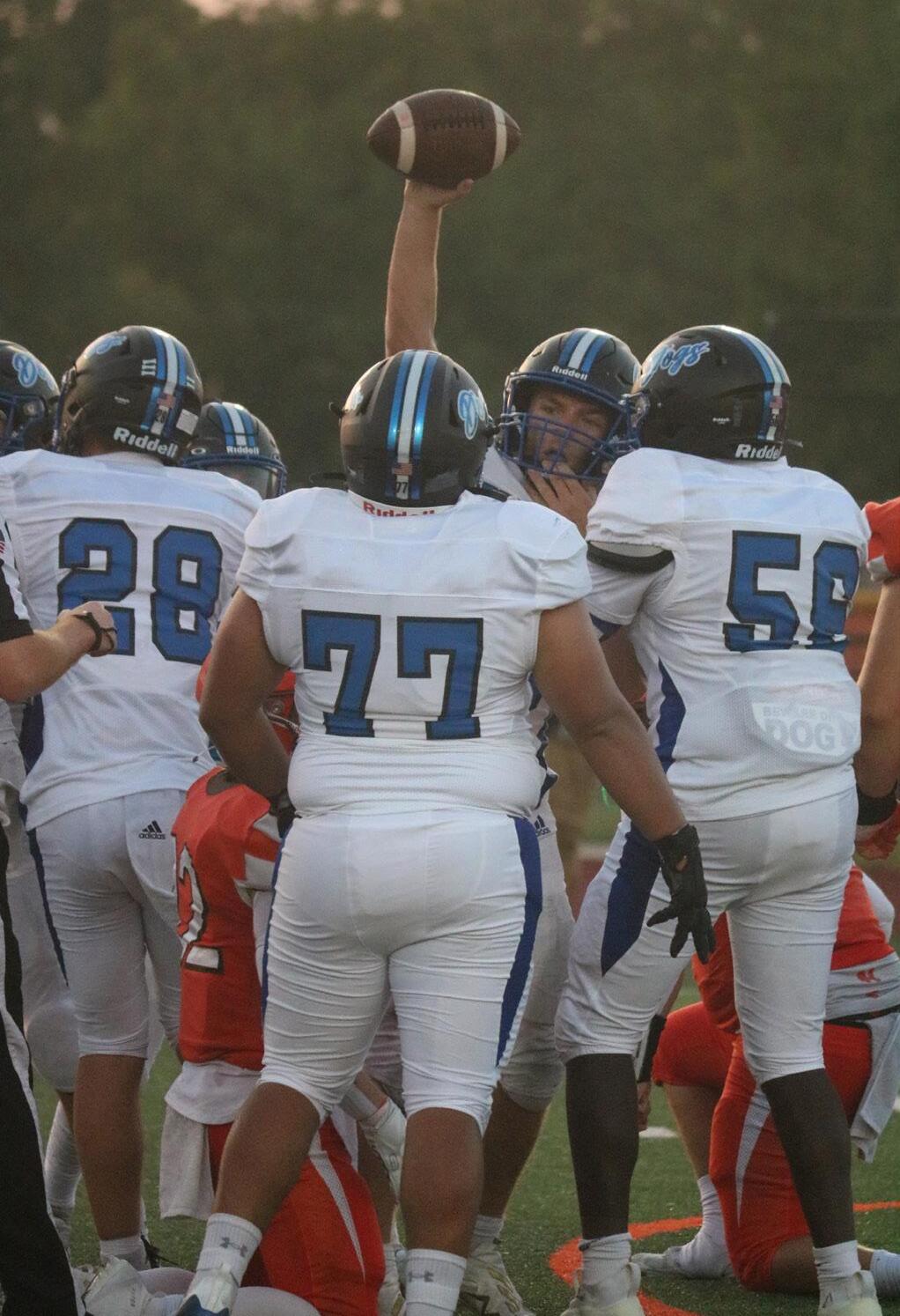
and our captains step up and do a good job of taking care of all of us,” sophomore Asher Ratliff said.
From a coaches point of view, Ratliff’s knowledge of the game is an asset to the team.
“He understands our offense better than anyone, therefore he’s able to help other guys with their assignment,” Haston said. “His teammates know that they can count on him to operate things at a high level.“
On a personal level, Ratliff also demonstrates his motivation to play the best he can.
“I’m always going to go out and leave everything I have out on the field, and give everything I can give to the team and go 110 percent% every rep,” Ratliff said.
For the rest of the season, both players and coaches see a positive outcome. According to players the team’s motto is “learn fast, play fast,” and they plan to achieve just that.
“Our team is incredibly young, but loaded with talent,” Haston said. “If we are able to mature beyond our years, learn fast and play even faster, then I believe this year will be very successful.”
OUT FOR THE COUNT
Time it takes for high school athletes take to recover from football-related ACL injuries
18%
less than 1 week
6% 8%
more than 3 weeks 1-3 weeks
39%
29% other* disqualified for season
*Season ended before athlete returned, athlete chose not to play, athlete disqualified for a non-medical reason
23
photo by Novah Ulm
Data from a study by the National Library of Medicine between 2007 and 2012
SPORTS
Bull Dogs face off against East on Aug. 25
GETTING INVOLVED
A comprehensive list of all the clubs here
design by Ajay Singireddy
Academic Super Bowl
Animation Club
Art Club
Beta Club
Biking Club
Bowling Club
Business Professionals of America (BPA)
Ceramics Club
Chess Club
CNHS Business Catalysts
Columbus FFA - National FFA
Computer Science and Cyber Security Club
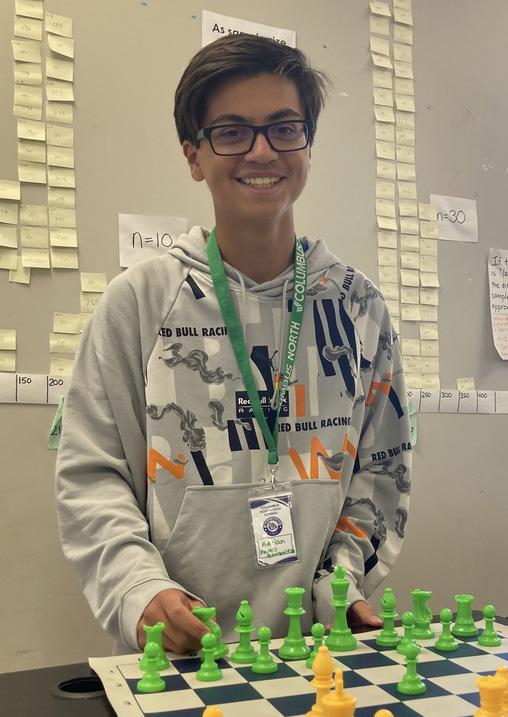

Debate (and Speech) Team
DECA
Dungeon’s and Dragons Club
Environmental Club
FCCLA
Fellowship of Christian Athletes (FCA)
French Club
German Club
GURU Talks
HOSA - Future Health Professionals
Japanime Club
Key Club
Kpop In Public Dance Team
L.O.V.E.
Math Modeling Team
Model United Nations
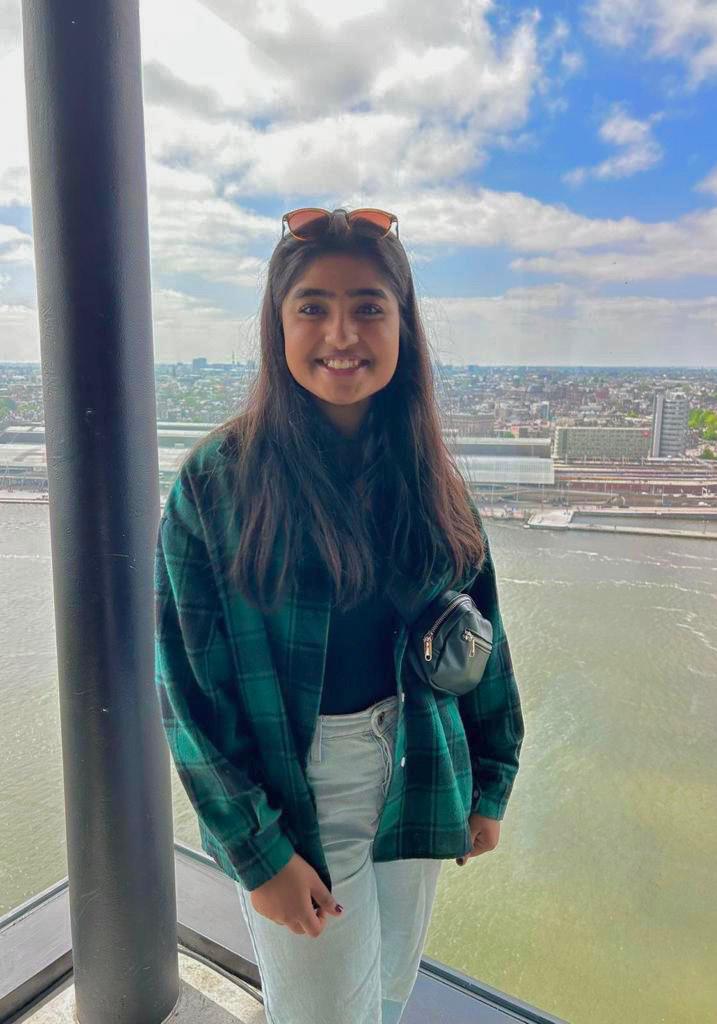
Movie Club
Multicultural Student Club
National Honor Society
Nature Conservation Club
North Drama
North Thespians, Troupe #57
Pediatric Cancer Awareness Club
Safe Space
Spanish Club
Spell Bowl
Stress Management Club
Student Assembly
Student Athletic Board
SWENEXT
Writer’s Workshop Club
“Art club is a club where people can have fun making art while exploring their potential.”
“In environmental club, we work to make a difference in our community and increase awareness for the environment we live in.”
“A club where people of all levels come to play chess, hang out, and have fun.”
junior Adrian Perez
junior Anushka Damle
senior Hilary Yang
photos for The Triangle


























 by Izzy Munn, Sylvia Sasse, Deshna Venkatachalam and Lydia Weed
by Izzy Munn, Sylvia Sasse, Deshna Venkatachalam and Lydia Weed









 by Jasmine Yang design by Sarynel Barbosa
by Jasmine Yang design by Sarynel Barbosa




